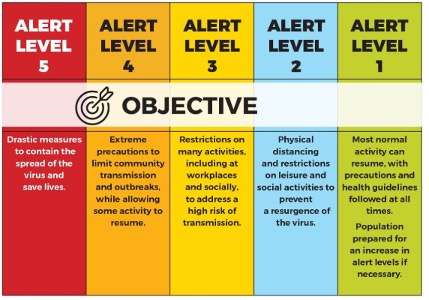Have you been staying inside as much as possible since late March? We’ve all had to do that and, of course, almost everything we’re used to being able to do has been stopped. For 5 weeks we have been living at Level 5 of the coronavirus lockdown. This has been very tough on everyone but it was essential to slow down the spread of the virus.
But, although coronavirus is still out there and spreading, the economy can’t stop for very long. And so, on Thursday, 24th April, President Ramaphosa announced the five alert levels that South Africa will follow from the 1st May.
This diagram sums up the different levels:

The level we are on depends on how much the coronavirus is spreading and how many people are ill and in hospital. The hospitals need to be able to accommodate the people who are ill and not be overwhelmed by sick patients. People also need to be able to earn money to buy food and live. This means that South Africans will find themselves living, for the next few months, on one of these levels.
Importantly, the level a particular area is on is dependent on the risk level of the spread of the coronavirus. If there is a high rate of infection in your area, it means that you may be on a higher level than someone in another part of the country where the rate of infection is low. This also means that areas will move up and down the levels dependent on the level of risk.
Here is a summary of each level:
LEVEL 5 – DRASTIC MEASURES
26 March – 30 April (we may need to return to this level if the spread of coronavirus gets out of control)
Under level 5, only essential services remain open. Essential services includes: health care providers and pharmacies; banks; supermarkets selling essential goods; petrol stations; and companies involved in food production, basic goods and medical supplies.
You are ONLY allowed to leave your house if you are: seeking medical care, buying groceries, visiting the pharmacy, accessing banking services, getting petrol or collecting a social grant.
LEVEL 4 – EXTREME PRECAUTION
This level starts countrywide on 1 May and will remain in place until otherwise announced by government. In this new phase more industries can operate but only under very strict conditions. This means that more people can leave their homes, but those who can stay and work from home are encouraged to do so.
People are able to access a wider range of goods and services, but they are still not able to buy alcohol or cigarettes. The aim remains to keep people in their homes as much as possible, this means that there is limited times available for solitary exercise and everyone needs to practice extreme care to limit the spread of the virus by wearing cloth masks outside of the home. Importantly, there is a curfew from 8pm until 5am each day.
Read more about Level 4 regulations here.
LEVEL 3 – RESTRICTIONS STILL IN PLACE
The restrictions in Level 3 are available in draft form only but it seems likely that the staff restrictions on the services in Level 4 will be lifted. Other services such as commercial building will be allowed to operate. Sale of hardware and all books will be available to the general public. Off-premises consumption of alcohol might be allowed as well as buying cigarettes. Manufacturing and sale of household appliances will be allowed. Laundries and dry-cleaners will open.
You will still not be able to meet friends or family and you will still need to wear a cloth mask. You will still need to stay 2 metres away from others and the curfew will remain.
LEVEL 2 – PHYSICAL DISTANCING AND SOME RESTRICTIONS
Life will be much easier under Level 2 restrictions although you will still need to be practicing social distancing. More services will be available and some inter-provincial travel may be allowed.
You will still need to stay at home and only travel for work and to purchase goods. Cloth masks will still need to be worn and large public gatherings will not be allowed. The curfew will remain in place.
LEVEL 1 – ALMOST BACK TO NORMAL
On Level 1 we will be able to go to the hairdresser and participate in other recreational activities such as culture and sport. There will be fewer limits on your movements. Masks will still be necessary and large public gatherings will still be restricted.
There is a lot that we don’t know as it remains to be seen how these restrictions will impact on the spread of the virus. The better we all are at restricting our exposure to coronavirus now, the sooner we will be able to relax the rules and go back to the life we used to have or, at least, to whatever will be seen as the ‘new normal’.
What we do know, though, are that these restrictions are mostly important and sensible as they will save the lives of many people in our country. Our day-to day living might be difficult but it will be worth it in the long run.
Stay safe and well.
Tell us: Did you find this useful? What questions about the levels do you have?


